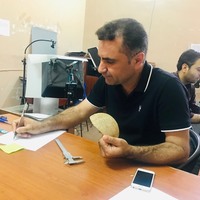Ardalan Khwshnaw
Salahaddin University-Erbil, Archaeology, Faculty Member
- Ecole Pratique des Hautes Etudes, Sciences Historiques et Philologiques, Graduate Studentadd
The Stone Ages are considered the longest age’s humans have lived on earth. These periods were named after the technical aspect of using stone mainly along with wood and bone to make tools used in one's daily life in those... more
The Stone Ages are considered the longest age’s humans have lived on earth. These periods were named after the technical aspect of using stone mainly along with wood and bone to make tools used in one's daily life in those periods. The division of these periods came on the basis of the shape and method of making the stone machines and the types of stones used to make them. The Koya district, as a part of the Iraqi-Kurdistan region, includes many archaeological sites dating back to these periods which are represented by a number of caves, shelters, valleys, and river banks, which times date back to different stages of these periods. According to the archaeological surveys that have been carried out in the areas of the Koya district and the visits to different areas of the district and the research that we have carried out, it has become clear to us that the Stone Age of the region, like the rest of the Kurdistan region, is divided into several roles, such as Paleolithic,...
Research Interests:
Research Interests:
Research Interests:
Research Interests:
Geographical History
Research Interests:
Royal Textes
Geographical History
Research Interests:
During the second excavation season of the Hungarian Archaeological Expedition of the Eötvös Loránd University, Budapest, we worked in four trenches on the tell of Grd-i Tle. In two trenches we continued the excavations of the previous... more
During the second excavation season of the Hungarian Archaeological Expedition of the Eötvös Loránd University, Budapest, we worked in four trenches on the tell of Grd-i Tle. In two trenches we continued the excavations of the previous season, and we also opened two brand new ones. The main goal was to gain further understanding in the topography and chronology of the settlement. We unearthed preserved parts of a city gate, a fortification wall, a building with a function yet unknown, and we continued to study the debris layers of the citadel wall. This year the main part of the discovered features belonged to the Hellenistic-Parthian period, but it seems like that we got close the Neo-Assyrian layer in some of the trenches as well.
Research Interests:
Research Interests:
This short letter of Samsu-iluna (1749-1712 B.C), king of Babylon, is preserved in the Slemani Museum, along with a number of other Old Babylonian documents. The article gives a brief overview of the letters of Samsuiluna. The short... more
This short letter of Samsu-iluna (1749-1712 B.C), king of Babylon, is preserved in the Slemani Museum, along with a number of other Old Babylonian documents. The article gives a brief overview of the letters of Samsuiluna. The short letter appears to be addressed to one Ipqu-Gula, who may be a šassukkum-official (the head of the cadastre-office) from Isin. The article presents a copy, transliteration, translation of and commentary on this cuneiform document, which adds to the small number of letters sent directly by Samsu-iluna that are currently available.
